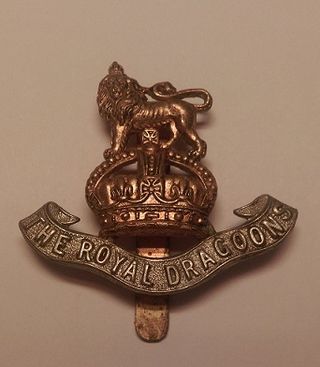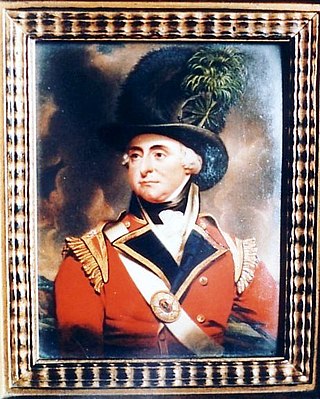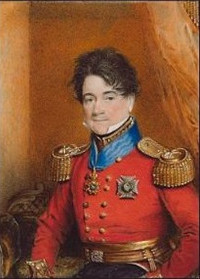Life
The son of the antiquary Lyde Browne, his baptism probably occurred on 3 May 1759 at St John Zachary, London. He entered the army as cornet in the 3rd Dragoons on 11 June 1777, and was soon promoted to command a troop in the 20th Light Dragoons (a corps produced for the American War of Independence by pulling the light troops out of other cavalry regiments). That regiment was disbanded in 1783 and Browne put on half-pay, though he returned to full pay in May 1794 with a position in the 40th Regiment of Foot. He served with them in the West Indies, where in 1794 he joined the 4th West India Regiment as a major. Next he was commissioned as major in the 90th Regiment of Foot (1798), then in 1800 lieutenant-colonel in the 35th Regiment of Foot (serving with them in Malta), followed by a lieutenant-colonelcy in the 85th Regiment of Foot (1801) and subsequently in the 21st Regiment of Foot.
On 25 January 1802, Browne was stationed with his regiment in Dublin). Alerted as to the uprising by Robert Emmet, he was shot dead by United Irishmen while returning to his men at dusk on 23 July. The rebels then straight afterwards moved to the next-door street, where they killed Lord Kilwarden.

The Royal Scots Greys was a cavalry regiment of the British Army from 1707 until 1971, when they amalgamated with the 3rd Carabiniers to form the Royal Scots Dragoon Guards.

Field Marshal Stapleton Cotton, 1st Viscount Combermere, was a British Army officer, diplomat and politician. As a junior officer, he took part in the Flanders Campaign, in the Fourth Anglo-Mysore War and in the suppression of Robert Emmet's insurrection in 1803. He commanded a cavalry brigade in Sir Arthur Wellesley's Army before being given overall command of the cavalry in the latter stages of the Peninsular War. He went on to be Commander-in-Chief, Ireland and then Commander-in-Chief, India. In the latter role he stormed Bharatpur—a fort which previously had been deemed impregnable.
Lieutenant-General Thomas Mahon, 2nd Baron Hartland, styled Hon. Thomas Mahon from 1800 to 1819, was an Irish soldier, politician and peer. Son of a landed proprietor with an estate at Strokestown, he joined the British Army, serving for most of his career with the 9th Light Dragoons. His garrison skillfully ambushed and destroyed a force of United Irishmen at the Battle of Carlow in 1798. He briefly represented County Roscommon in the Irish and UK Parliaments as part of his father's successful scheme to obtain a peerage by supporting the Union, but this was not popular with the county electors, and he abandoned Parliament in 1802 to return to the military. He had the misfortune to be present at two military debacles of the Napoleonic Wars, the second invasion of the Río de la Plata and the Walcheren Campaign, and while he was not personally implicated in either, he saw no further notable military service. Mahon succeeded his father as Lord Hartland in 1819 and died without issue in 1835, his title and estates passing to his youngest brother.

The Royal Dragoons was a heavy cavalry regiment of the British Army. The regiment was formed in 1661 as the Tangier Horse. It served for three centuries and was in action during the First and the Second World Wars. It was amalgamated with the Royal Horse Guards to form The Blues and Royals in 1969.

General John Hely-Hutchinson, 2nd Earl of Donoughmore, GCB KC was an Anglo-Irish politician, hereditary peer and soldier.

The 15th The King's Hussars was a cavalry regiment in the British Army. First raised in 1759, it saw service over two centuries, including the First World War, before being amalgamated with the 19th Royal Hussars into the 15th/19th The King's Royal Hussars in 1922.
Lieutenant-General James Montgomerie was a Scottish soldier and politician who sat in Parliament for Ayrshire 1818–29.
Lieutenant-General Richard Stovin was a British Army officer during the late eighteenth and early nineteenth centuries. He originally joined the army as an ensign in 1780, and saw service in the American War of Independence, where he may have been taken prisoner after the Battle of Yorktown. After the outbreak of the French Revolutionary Wars, he saw service with a force sent to invade French colonies in the Caribbean, and was taken prisoner in 1794 at Guadeloupe. Released after two years in captivity, he later commanded his regiment in the Netherlands, in the Anglo-Russian invasion of Holland of 1799, and on garrison duties in the Mediterranean and in India. In the War of 1812 he was appointed to command a division in the forces in Canada, where an island in the St. Lawrence river was named after him.
Sir Gregory Holman Bromley Way (1776–1844) was an English lieutenant-general.
John Granby Clay (1766–1846), was a British Army general.

General Robert Manners was a British Army officer and Member of Parliament.
General Sir James Steuart Denham, 8th and 4th Baronet was a Scottish soldier of the British Army.
Russell Manners was a British Army officer.
The plan of raising a fencible corps in the Highlands was first proposed and carried into effect by William Pitt the Elder, in the year 1759. During the three preceding years, both the fleets and armies of Great Britain had suffered reverses, and it was thought that a "home guard" was necessary as a bulwark against invasion.

General Sir John Ormsby Vandeleur was a British Army officer who fought in the French Revolutionary and Napoleonic wars.
Lieutenant-General Sir Wiltshire Wilson was a general officer of the British Army who served in the Royal Artillery for some forty-five years, including several campaigns of the Revolutionary and Napoleonic Wars.
Lieutenant-General Sir Henry George Grey GCB GCH was a British Army officer who served as acting Governor of Cape Colony.

General Sir Thomas Hawker KCH was a British Army cavalry officer. Hawker began his career in the 11th Light Dragoons in 1795 and fought with them during the 1799 Anglo-Russian invasion of Holland. In 1804, he purchased the rank of major with the 20th Light Dragoons and served with them in Spain during the Peninsular War. He was promoted to command of the regiment in 1808. Hawker served in the force sent to occupy the Republic of Genoa in 1814 and shortly after was promoted to colonel and given command of a light cavalry brigade. Spending some time on half pay after the end of the Napoleonic Wars he returned to active service as lieutenant-colonel of the 13th Light Dragoons. Hawker was in the East Indies between 1822--26 and 1830-36 and was promoted to major-general in 1825. He was appointed a Knight Commander of the Royal Guelphic Order in 1837 and colonel of the 6th Regiment of Dragoon Guards in 1839. Hawker was promoted to the brevet rank of general in 1854.
The Windsor Foresters, or more formally the Berkshire Fencible Cavalry, was a British regiment of cavalry raised for home defence in 1794. It served in Lincolnshire and Scotland on coastal defence and anti-smuggling duties until 1800. A second regiment, the Berkshire Provisional Cavalry was converted into fencible cavalry in 1799. Both regiments were disbanded in 1800, when a number of members transferred to a new Yeomanry Cavalry Troop at Wargrave.
Major-General George Johnstone was a British Army officer. He was commissioned into the infantry 1780, serving in Grenada during Fédon's rebellion in 1795-96. He was afterwards transferred to command a regiment of fencibles in New Brunswick, where he served for a year as acting Lieutenant Governor. In 1810, he was given command of a Highland regiment which served on garrison duty in Cape Colony. Johnstone was promoted to major general in 1814 and given command of the 6th Brigade in the 1815 Waterloo campaign. His brigade was not engaged in the 18 June Battle of Waterloo as they were posted to the extreme right flank, protecting the approaches to Brussels and Ostend. His men fought in the subsequent advance to Paris and helped to storm the fortress of Cambrai on 24 June.







